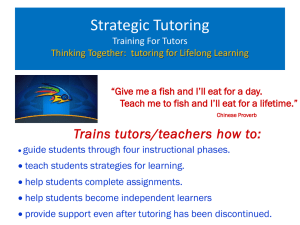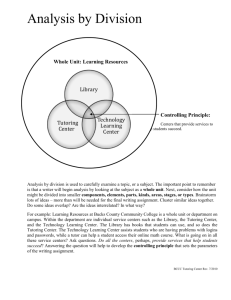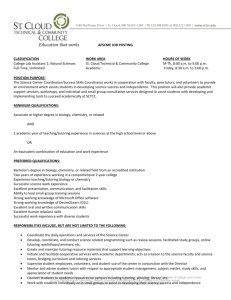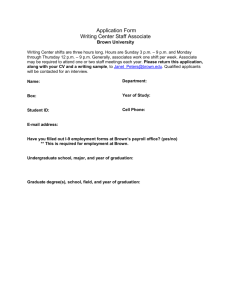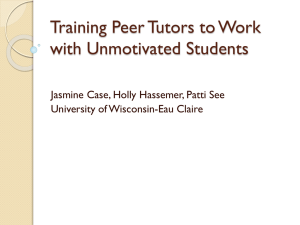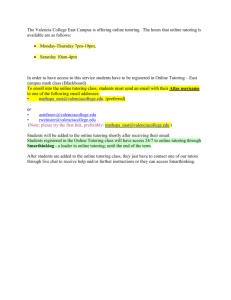Tutoring in Language Learning and Teaching
advertisement
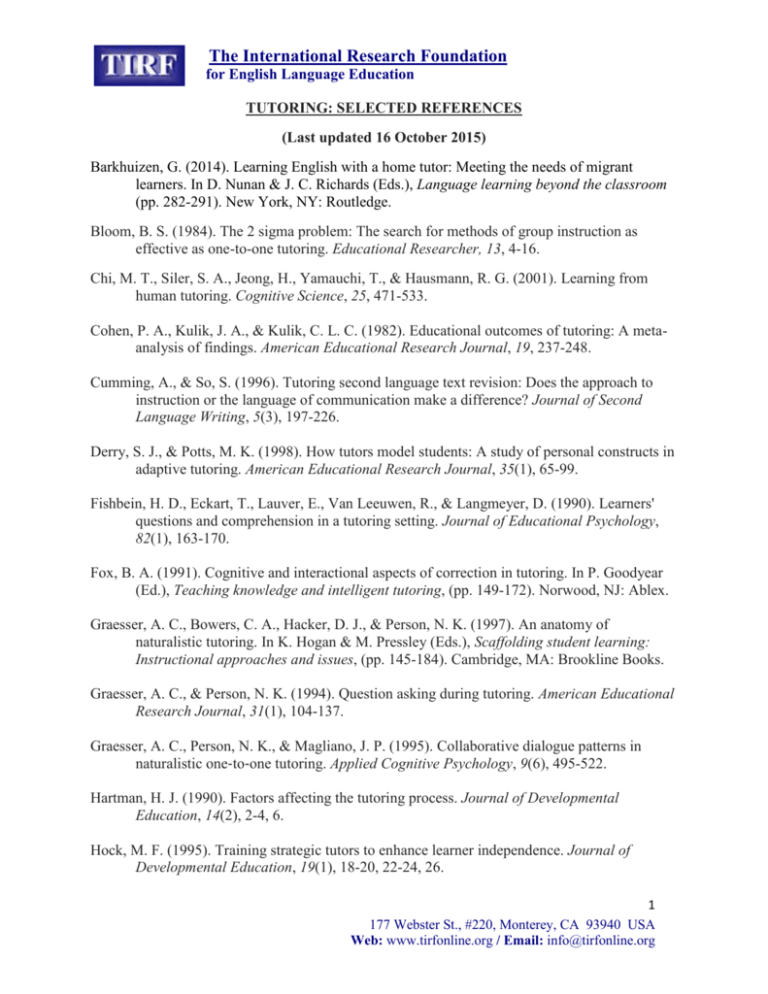
The International Research Foundation for English Language Education TUTORING: SELECTED REFERENCES (Last updated 16 October 2015) Barkhuizen, G. (2014). Learning English with a home tutor: Meeting the needs of migrant learners. In D. Nunan & J. C. Richards (Eds.), Language learning beyond the classroom (pp. 282-291). New York, NY: Routledge. Bloom, B. S. (1984). The 2 sigma problem: The search for methods of group instruction as effective as one-to-one tutoring. Educational Researcher, 13, 4-16. Chi, M. T., Siler, S. A., Jeong, H., Yamauchi, T., & Hausmann, R. G. (2001). Learning from human tutoring. Cognitive Science, 25, 471-533. Cohen, P. A., Kulik, J. A., & Kulik, C. L. C. (1982). Educational outcomes of tutoring: A metaanalysis of findings. American Educational Research Journal, 19, 237-248. Cumming, A., & So, S. (1996). Tutoring second language text revision: Does the approach to instruction or the language of communication make a difference? Journal of Second Language Writing, 5(3), 197-226. Derry, S. J., & Potts, M. K. (1998). How tutors model students: A study of personal constructs in adaptive tutoring. American Educational Research Journal, 35(1), 65-99. Fishbein, H. D., Eckart, T., Lauver, E., Van Leeuwen, R., & Langmeyer, D. (1990). Learners' questions and comprehension in a tutoring setting. Journal of Educational Psychology, 82(1), 163-170. Fox, B. A. (1991). Cognitive and interactional aspects of correction in tutoring. In P. Goodyear (Ed.), Teaching knowledge and intelligent tutoring, (pp. 149-172). Norwood, NJ: Ablex. Graesser, A. C., Bowers, C. A., Hacker, D. J., & Person, N. K. (1997). An anatomy of naturalistic tutoring. In K. Hogan & M. Pressley (Eds.), Scaffolding student learning: Instructional approaches and issues, (pp. 145-184). Cambridge, MA: Brookline Books. Graesser, A. C., & Person, N. K. (1994). Question asking during tutoring. American Educational Research Journal, 31(1), 104-137. Graesser, A. C., Person, N. K., & Magliano, J. P. (1995). Collaborative dialogue patterns in naturalistic one‐to‐one tutoring. Applied Cognitive Psychology, 9(6), 495-522. Hartman, H. J. (1990). Factors affecting the tutoring process. Journal of Developmental Education, 14(2), 2-4, 6. Hock, M. F. (1995). Training strategic tutors to enhance learner independence. Journal of Developmental Education, 19(1), 18-20, 22-24, 26. 1 177 Webster St., #220, Monterey, CA 93940 USA Web: www.tirfonline.org / Email: info@tirfonline.org The International Research Foundation for English Language Education Hume, G., Michael, J., Rovick, A., & Evens, M. (1996). Hinting as a tactic in one-on-one tutoring. The Journal of the Learning Sciences, 5(1), 23-47. Lepper, M. R., Aspinwall, L. G., Mumme, D.L., & Chabay, R. W. (1990). Self-perception and social-perception processes in tutoring: Subtle social control strategies of expert tutors. In J. M. Olson & M. P. Zanna (Eds.), Self-inference processes: The Ontario symposium (pp. 217-237). Hillsdale, NJ: Erlbaum. Lepper, M. R., & Chabay, R. W. (1988). Socializing the intelligent tutor: Bringing empathy to computer tutors. In H. Mandl & A. Lesgold (Eds.), Learning issues for intelligent tutoring systems (pp. 242-257). New York: Springer-Verlag. Lepper, M. R., Drake, M. F., & O'Donnell-Johnson, T. (1997). Scaffolding techniques of expert human tutors. In K. Hogan & M. Pressley (Eds.), Scaffolding student learning: Instructional approaches and issues (pp. 108-144). Cambridge, MA: Brookline Books. Lepper, M. R., Woolverton, M., Mumme, D. L., & Gurtner, J. (1993). Motivational techniques of expert human tutors: Lessons for the design of computer-based tutors. In S.P. Lajoie & S.J. Derry (Eds.), Computers as cognitive tools, (pp. 75-105). Hillsdale, NJ: Erlbaum. MacDonald, R. B. (1991). An analysis of verbal interaction in college tutorials. Journal of Developmental Education, 15(1), 2-4, 6, 8, 10, 12. Matthews, P. H. (2008). Achievement motivational characteristics of university foreign language learners: From the classroom to the tutoring table. Foreign Language Annals, 41(4), 611626. McArthur, D., Stasz, C., & Zmuidzinas, M. (1990). Tutoring techniques in algebra. Cognition and Instruction, 7(3), 197-244. Medway, F. J., & Baron, R. M. (1977). Locus of control and tutor's instructional style as determinants of cross-age tutoring effectiveness. Contemporary Educational Psychology, 2(3), 298-310. Merrill, D. C., Reiser, B. J., Merrill, S. K., & Landes, S. (1995). Tutoring: Guided learning by doing. Cognition and Instruction, 13(3), 315-372. Merrill, D. C., Reiser, B. J., Ranney, M., & Trafton, J. G. (1992). Effective tutoring techniques: A comparison of human tutors and intelligent tutoring systems. Journal of the Learning Sciences, 2(3), 277-305. Person, N. K., & Graesser, A. C. (1999). Evolution of discourse during cross-age tutoring. In A.M. O’Donnell & A. King (Eds.), Cognitive perspectives on peer learning (pp. 69-86). Mahwah, NJ: Erlbaum. 2 177 Webster St., #220, Monterey, CA 93940 USA Web: www.tirfonline.org / Email: info@tirfonline.org The International Research Foundation for English Language Education Person, N. K., Graesser, A. C., Magliano, J. P., & Kreuz, R. J. (1994). Inferring what the student knows in one-to-one tutoring: The role of student questions and answers. Learning and Individual Differences, 6(2), 205-229. Pearson, N. K., Kreuz, R. J., Zwaan, R. A., & Graesser, A. C. (1995). Pragmatics and pedagogy: Conversational rules and politeness strategies may inhibit effective tutoring. Cognition and instruction, 13(2), 161-188. Putnam, R. T. (1987). Structuring and adjusting content for students: A study of live and simulated tutoring of addition. American Educational Research Journal, 24(1), 13-48. Rings, S., & Sheets, R. A. (1991). Student development and metacognition: Foundations for tutor training. Journal of Developmental Education, 15(1), 30-32. Thonus, T. (1999). Dominance in academic writing tutorials: Gender, language proficiency, and the offering of suggestions. Discourse & Society, 10(2), 225-248. Thonus, T. (2002). Tutor and student assessments of academic writing tutorials: What is “success”?. Assessing Writing, 8(2), 110-134. VanLehn, K., Graesser, A. C., Jackson, G. T., Jordan, P. W., Olney, A., & Rosé, C. P. (2006). When are tutorial dialogues more effective than reading? Cognitive Science, 30, 1-60. VanLehn, K., Siler, S., Murray, C., Yamauchi, T., & Baggett, W. B. (2003). Why do only some events cause learning during human tutoring?. Cognition and Instruction, 21(3), 209-249. 3 177 Webster St., #220, Monterey, CA 93940 USA Web: www.tirfonline.org / Email: info@tirfonline.org
